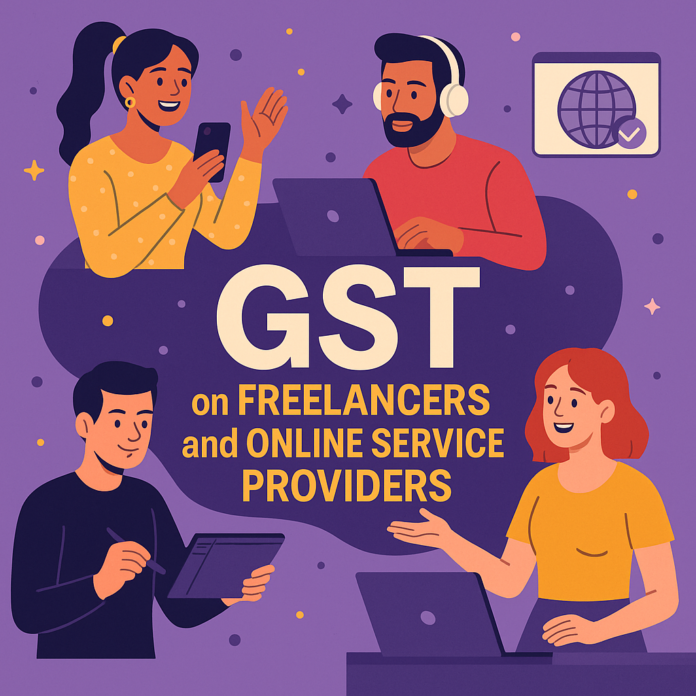Are you a freelancer or offering online services in India? Then understanding GST is a must. Whether you’re designing logos, writing content, building websites, or running online classes, GST could impact how you invoice clients and file taxes.
In this guide, you’ll find everything you need to know, explained simply and practically.
What is a Freelancer or Online Service Provider under GST?
You’re a freelancer or service provider if you independently offer services like:
- Graphic and web design
- Writing or editing
- Digital marketing
- Consulting
- Online tutoring or courses
- IT support, software development, or SaaS services
GST treats all of these as taxable services, and you’re expected to follow the rules accordingly.
Do You Need to Register for GST?
Basic Rule
You must register for GST if your total turnover exceeds ₹20 lakhs in a financial year (₹10 lakhs for special category states like those in the Northeast).
But it’s not just about turnover. Some freelancers must register even if they earn less.
Situations Where GST Registration is Mandatory – No Matter Your Turnover
- You work with international clients (export of services)
Even ₹1 of overseas income requires GST registration if you want to claim benefits or refunds. - You want to claim input tax credit (ITC)
On services like paid tools, software, or office expenses. - You work on platforms like Upwork, Fiverr, or sell online courses
Registration strengthens your position when platforms require GST details.
How Much GST Do You Charge?
In most cases, the GST rate is 18% for professional services. It applies to:
- Consultancy
- IT services
- Content creation
- Online courses
You either charge IGST (18%) for clients outside your state/country or CGST + SGST (9% + 9%) for clients within your state.
Invoicing and Return Filing – What You Need to Do
If you’re registered:
- Issue GST-compliant invoices with SAC codes
- Maintain proper records
- File monthly/quarterly returns (GSTR-1 and GSTR-3B)
- If exporting, file Letter of Undertaking (LUT) to avoid tax on invoices
Freelancer Example 1: Anaya, Indian Clients Only
Priya, a freelance social media manager from Jaipur, earns ₹18 lakhs a year from Indian startups. Since she operates only in Rajasthan and her turnover is below ₹20 lakhs, she’s not required to register for GST.
But if her income crosses ₹20 lakhs, GST registration becomes mandatory. She’ll then start charging GST on all her invoices.
Freelancer Example 2: Sneha, Global Clients
Sneha, a UX designer based in Bangalore, earns ₹12 lakhs from clients in Germany and the US via Fiverr. Even though she hasn’t hit the ₹20 lakh mark, her income qualifies as export of services.
To treat it as zero-rated and claim any input tax credit, Sneha must register for GST, submit a LUT, and file regular returns.
What Counts as Export of Services?
To call your freelance earnings “exports” under GST, these five conditions must be met:
- You’re in India
- Your client is outside India
- Service is provided across borders
- Payment is in foreign currency
- Your client isn’t just a branch or office in India
When these are true, GST is not charged – it’s a zero-rated supply.
Can Freelancers Opt for the Composition Scheme?
In general, no. Freelancers and service providers cannot use the Composition Scheme unless:
- Their turnover is below ₹50 lakhs
- They are not exporting services
- They serve only within their own state
Even then, they must pay GST at 6% but cannot claim input credit or make interstate sales.
What If You Ignore GST?
Skipping GST registration when required can lead to:
- Penalties starting from ₹10,000
- Interest on tax dues
- Notices from the tax department
It’s better to register early and stay compliant.
Final Takeaway
Here’s the simple rule:
If your turnover exceeds ₹20 lakhs, or you serve foreign clients, get GST registered.
This gives you access to legal benefits, refunds, and a professional edge.
Still unsure? Speak to a GST expert or CA. Setting things up correctly now saves major stress later.



